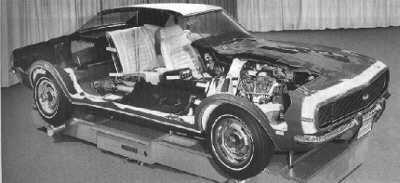The
History Of
Camaro

Chevrolet General Manager E.M. "Pete" Estes
setting off the Camaro explosion, September 21, 1966.
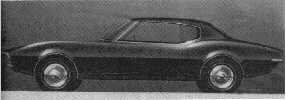 |
 |
| 1963
airbrush rendering for Project XP-836, which became the Camaro |
June 1962 clay model of the XP-836 |
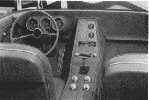 under the direction of Henry
under the direction of Henry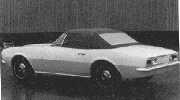
![]() The designers
The designers ![]() did mock-ups of
many
did mock-ups of
many![]() different models, including
different models, including ![]() a two-seat roadster, a fastback,
a two-seat roadster, a fastback, ![]() and a station
wagon. GM was
and a station
wagon. GM was![]() trying to keep the cost as low as
trying to keep the cost as low as![]() possible, however, to compete with
possible, however, to compete with![]() the Mustang, and
decided to
the Mustang, and
decided to![]() stick
with just two models, a
stick
with just two models, a ![]() coupe and a convertible.
coupe and a convertible.![]()
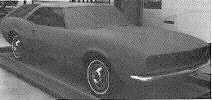
![]() The Camaro
The Camaro![]() was to be offered
with a wide
was to be offered
with a wide ![]() variety
of powerplants,
variety
of powerplants,![]() ranging from a 230 cubic inch
ranging from a 230 cubic inch ![]() six cylinder to a
327 V8.
six cylinder to a
327 V8.![]() In
addition, a new engine displacement
In
addition, a new engine displacement ![]() was created just for
was created just for![]() the Camaro, a 350
cubic inch V8 rated
the Camaro, a 350
cubic inch V8 rated![]() at 295 horsepower.
at 295 horsepower. ![]()
![]() As the
As the![]() launch date
neared, the car still had
launch date
neared, the car still had ![]() no name. It had been called
no name. It had been called![]() various names by
GM and the press, including Nova, Panther, Chaparral,
various names by
GM and the press, including Nova, Panther, Chaparral, ![]() and Wildcat (later
used by Buick.) It is rumored that Chevy also considered
and Wildcat (later
used by Buick.) It is rumored that Chevy also considered ![]() using the letters
"GM" in the name, and came up with
using the letters
"GM" in the name, and came up with ![]() G-Mini, which
evolved into GeMini, and finally Gemini.
G-Mini, which
evolved into GeMini, and finally Gemini.![]() General Motors Headquarters supposedly killed
that name,
General Motors Headquarters supposedly killed
that name,![]() because they didn't want the letters "GM"
because they didn't want the letters "GM" ![]() used in case the
car was a
used in case the
car was a![]() failure.
failure.
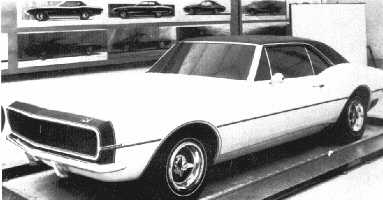
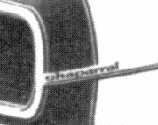
This pre-release car bears "Chaparral" name.
![]() Finally,
Finally, ![]() the car was
introduced to the press as the Camaro,
the car was
introduced to the press as the Camaro, ![]() considered to be a good name because
considered to be a good name because![]() nobody knew what
it meant. Chevrolet produced an
nobody knew what
it meant. Chevrolet produced an ![]() old French dictionary showing that the word
meant
old French dictionary showing that the word
meant ![]() "friend"
or "companion", but Ford found an alternate meaning in an
"friend"
or "companion", but Ford found an alternate meaning in an ![]() old Spanish
dictionary-"a small,
old Spanish
dictionary-"a small, ![]() shrimp-like creature."The automotive press
had a good
shrimp-like creature."The automotive press
had a good![]() laugh over that, and an even bigger
laugh over that, and an even bigger![]() one when one journalist found yet another
meaning-"loose bowels." It
one when one journalist found yet another
meaning-"loose bowels." It ![]() didn't take long for the laughter to
didn't take long for the laughter to![]() stop after the
introduction of the stunning 1967
stop after the
introduction of the stunning 1967 ![]() Camaro!
Camaro!
